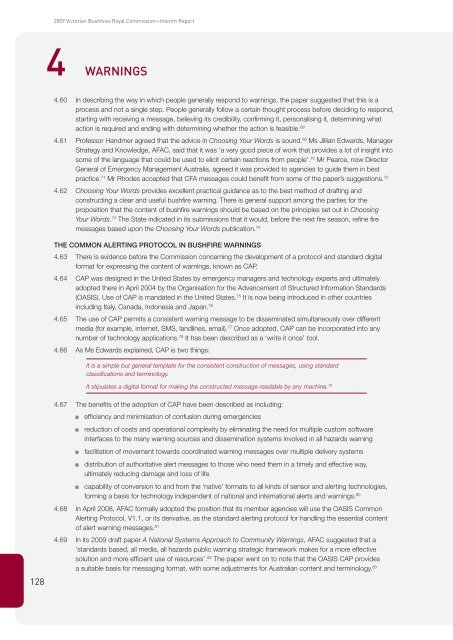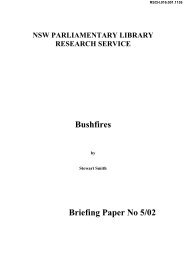Chapter 4 - Warnings - 2009 Victorian Bushfires Royal Commission
Chapter 4 - Warnings - 2009 Victorian Bushfires Royal Commission
Chapter 4 - Warnings - 2009 Victorian Bushfires Royal Commission
You also want an ePaper? Increase the reach of your titles
YUMPU automatically turns print PDFs into web optimized ePapers that Google loves.
<strong>2009</strong> <strong>Victorian</strong> <strong>Bushfires</strong> <strong>Royal</strong> <strong>Commission</strong>—Interim Report<br />
4 WARNINGS<br />
4.60<br />
In describing the way in which people generally respond to warnings, the paper suggested that this is a<br />
process and not a single step. People generally follow a certain thought process before deciding to respond,<br />
starting with receiving a message, believing its credibility, confirming it, personalising it, determining what<br />
action is required and ending with determining whether the action is feasible. 68<br />
4.61 Professor Handmer agreed that the advice in Choosing Your Words is sound. 69 Ms Jillian Edwards, Manager<br />
Strategy and Knowledge, AFAC, said that it was ‘a very good piece of work that provides a lot of insight into<br />
some of the language that could be used to elicit certain reactions from people’. 70 Mr Pearce, now Director<br />
General of Emergency Management Australia, agreed it was provided to agencies to guide them in best<br />
practice. 71 Mr Rhodes accepted that CFA messages could benefit from some of the paper’s suggestions. 72<br />
4.62 Choosing Your Words provides excellent practical guidance as to the best method of drafting and<br />
constructing a clear and useful bushfire warning. There is general support among the parties for the<br />
proposition that the content of bushfire warnings should be based on the principles set out in Choosing<br />
Your Words. 73 The State indicated in its submissions that it would, before the next fire season, refine fire<br />
messages based upon the Choosing Your Words publication. 74<br />
The Common Alerting Protocol IN BUSHFIRE WARNINGS<br />
4.63 There is evidence before the <strong>Commission</strong> concerning the development of a protocol and standard digital<br />
format for expressing the content of warnings, known as CAP.<br />
4.64<br />
4.65<br />
4.66<br />
CAP was designed in the United States by emergency managers and technology experts and ultimately<br />
adopted there in April 2004 by the Organisation for the Advancement of Structured Information Standards<br />
(OASIS). Use of CAP is mandated in the United States. 75 It is now being introduced in other countries<br />
including Italy, Canada, Indonesia and Japan. 76<br />
The use of CAP permits a consistent warning message to be disseminated simultaneously over different<br />
media (for example, internet, SMS, landlines, email). 77 Once adopted, CAP can be incorporated into any<br />
number of technology applications. 78 It has been described as a ‘write it once’ tool.<br />
As Ms Edwards explained, CAP is two things:<br />
It is a simple but general template for the consistent construction of messages, using standard<br />
classifications and terminology.<br />
It stipulates a digital format for making the constructed message readable by any machine. 79<br />
128<br />
4.67<br />
4.68<br />
The benefits of the adoption of CAP have been described as including:<br />
■■ efficiency and minimisation of confusion during emergencies<br />
■■ reduction of costs and operational complexity by eliminating the need for multiple custom software<br />
interfaces to the many warning sources and dissemination systems involved in all hazards warning<br />
■■ facilitation of movement towards coordinated warning messages over multiple delivery systems<br />
■■ distribution of authoritative alert messages to those who need them in a timely and effective way,<br />
ultimately reducing damage and loss of life<br />
■■ capability of conversion to and from the ‘native’ formats to all kinds of sensor and alerting technologies,<br />
forming a basis for technology independent of national and international alerts and warnings. 80<br />
In April 2008, AFAC formally adopted the position that its member agencies will use the OASIS Common<br />
Alerting Protocol, V1.1, or its derivative, as the standard alerting protocol for handling the essential content<br />
of alert warning messages. 81<br />
In its <strong>2009</strong> draft paper<br />
4.69 A National Systems Approach to Community <strong>Warnings</strong>, AFAC suggested that a<br />
‘standards based, all media, all hazards public warning strategic framework makes for a more effective<br />
solution and more efficient use of resources’. 82 The paper went on to note that the OASIS CAP provides<br />
a suitable basis for messaging format, with some adjustments for Australian content and terminology. 83
















